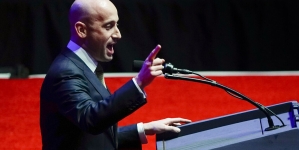-
L.A. wildfires cause $350 million in damage to city facilities - 13 hours ago
-
2 Dead in Antioch High School Shooting, Nashville Police Say - 22 hours ago
-
Israeli Military Begins West Bank Raids - January 21, 2025
-
L.A. area faces unprecedented 5th ‘particularly dangerous’ fire warning - January 20, 2025
-
Trump Will Strip Protections from Career Civil Servants, Miller Says - January 20, 2025
-
Two Prominent Judges Are Shot Dead Outside Iran’s Supreme Court - January 18, 2025
-
Can Communities Survive the Fires? - January 17, 2025
-
Biden and Trump Defy Their History of Animosity to Seal Gaza Cease-Fire - January 16, 2025
-
Angel City’s Ali Riley lost childhood home to wildfires. Her wedding became an ‘oasis’ - January 15, 2025
-
U.S. Oil Production Is Booming. Oil Jobs Are Not. - January 14, 2025
Can Stony Brook University Balance Equity and Ambition?
Shortly after she became governor of New York, Kathy Hochul made an announcement that caught the higher-education world off guard: The state, which has generally regarded all its public universities as equals, would start treating two universities as “flagships.”
More surprising still, her choices for the elite label didn’t include Binghamton University, which has often been regarded as New York’s top academic public university. Instead, the governor said the distinction would go to Stony Brook University, on Long Island, and the University at Buffalo, in her hometown.
For leaders at Stony Brook, the promotion wasn’t at all a surprise. It was the next step in a yearslong campaign to transform the institution from a well-regarded regional school, where nearly half the students are from Long Island, to a globally renowned research institution, or as administrators like to say, the “Berkeley of the East.”
The flagship designation is only honorary. “It has rhetorical power, more than anything else,” Stony Brook’s president, Maurie McInnis, said in an interview. But in the two years since the announcement, Stony Brook has moved aggressively to live up to its new title, advertising its new status widely to recruit students and donors.
Its place in U.S. News & World Report’s college rankings has jumped from No. 93 to No. 58. It has secured funds that will nearly triple its endowment, including one of the largest donations to a university in American history. And it won the rights to develop a climate solutions lab on a large chunk of real estate on Governors Island, beating out some of New York’s largest and most prestigious institutions.
But some observers wonder whether the school’s advancement will come at the cost of equity. They suggest that other schools in the State University of New York system could get short shrift. They also worry that Stony Brook, where 16 percent of students come from families in the bottom fifth of American income levels, could be transformed into a school that is more elite in every sense.
John Friedman, the chair of Brown University’s economics department, who has done extensive research on the role of universities in promoting social mobility, said this kind of drift is all but inevitable: “I do think that making it more selective will make it more difficult to bring in the same number of low-income students as before.”
The SUNY system as it exists today was established in the 1950s, cobbled together from teachers’ colleges, agricultural schools and other existing institutions, including the University at Buffalo. Part of the original aim was to establish high-caliber public universities all over the state, so that no New Yorker would be far from one.
Stony Brook, which opened in 1957 as part of that effort, had a relatively modern design, a far cry from the stately, neo-Gothic style of some Ivy League schools, reflecting both its recent origins and its concentration on science and technology.
More than half of students are commuters, and it has never been known for having a robust campus culture. But even in the early days, leaders at both Stony Brook and Buffalo were ambitious.
Still, Stony Brook became known for its success at helping poor students: In 2017, it was ranked the third best in the nation for social mobility, according to metrics designed by Friedman and his colleagues. More than half of its students from low-income households end up in the top fifth of earners nationally after getting their degrees.
Equity has always been “part of Stony Brook’s DNA,” as Ms. McInnis put it. She said the school has often attracted faculty who appreciate its “public service mission.”
When Stony Brook assembled a committee to choose a new president in late 2019, the leadership saw it as a chance to revive its global ambitions, said Rich Gelfond, the chief executive of the IMAX Corporation and the chair of the university’s fund-raising arm.
He said the trustees — among them Jim Simons, who taught in the math department before making billions as a hedge fund manager — sought out an administrator who understood the levers of power in public higher education.
Ms. McInnis, an art historian by background who joined in 2020, was a savvy veteran of two of America’s most prestigious public universities, the University of Virginia and the University of Texas at Austin.
“She really knew how to navigate” this world, Mr. Gelfond said.
Early on, Ms. McInnis persuaded donors to set up a $75 million fund that she could personally use for “strategic opportunities.” When, in the summer of 2021, the city announced it was launching a global competition for the Governors Island climate center, Ms. McInnis drew $7 million to assemble a detailed proposal. Stony Brook recruited a number of other institutions, including the Georgia Institute of Technology, Pratt Institute and IBM, to sign on as partners.
“When I saw that, I immediately knew that it was something we had to compete for — and that, frankly, we had to win,” she said.
They did. In the meantime, the governor bestowed the flagship label, choosing the state’s two big research universities to receive it.
But legislators representing Binghamton and Albany were dismayed; at least five signed letters to the governor, expressing concerns that her decision would put their own local universities at a material disadvantage.
This past February, Ms. Hochul said she wanted the state to provide a 50 percent match for any donations made to the endowments at New York’s four largest universities, which also included Binghamton and Albany. The Legislature passed the matching plan in the spring.
Four weeks later, Simons and his wife, Marilyn Simons, announced they were donating $500 million to Stony Brook — believed to be the largest unrestricted donation an American public university has ever received.
The Stony Brook Foundation, the university’s fund-raising arm, had lobbied for the state’s matching program, Mr. Gelfond said, knowing it would help with appeals to donors — and then used the program to persuade the Simonses to make the historic gift.
United University Professors, the union that represents SUNY professors, is concerned that the new flagship designation will lead to the neglect of smaller institutions, like community colleges and technical schools, said Frederick Kowal, the union’s statewide president. He said this has occurred in other states, like California, where public universities are grouped into distinct tiers.
For their part, leaders at Stony Brook and SUNY tend to argue that it’s not a zero-sum game. If Stony Brook can bring in more federal research dollars, it could raise the profile of the SUNY system overall and spur economic development to boot, said John King, the SUNY chancellor.
In a statement, a spokeswoman for the Simons Foundation, Anastasia Greenebaum, said that they “do not regard support of Stony Brook as giving the school ‘advantage’ over other state schools, or creating tiers. Any one SUNY school receiving additional financial support so that it may excel does not lower or lessen other schools.” They said that improvements to the university ultimately benefited the New Yorkers who can attend.
Prospective students and their parents also seem to be taking note of Stony Brook’s growing stature. For the current academic year, the university received more than 50,000 freshman applications — a 24 percent increase from the year before. The freshman class was also its largest ever, with 3,567 students. (Applications have also risen at other SUNY schools, thanks in part to an application fee waiver the state introduced last year.)
On one hand, the school’s growing popularity is a sign of success. On the other hand, it raises concerns of balancing growth and inclusiveness.
“There’s a ceiling in terms of the growth, even of a campus like Stony Brook,” Mr. Kowal, the union president, said. “How big will they get? Are we talking about Ohio State, with tens of thousands of students, or are we talking Chapel Hill, which is smaller? At that point, it becomes more selective.”
Stony Brook administrators noted that over the last decade, more low-income students have enrolled even as admissions have become more selective.
Ms. McInnis said she is focused on immediate concerns. As more money flows in, she said, the first priorities will be hiring more faculty and upgrading the oldest campus facilities. “The next president will love me — and thank me,” she said.
As to whether the growth could compromise the school’s already established success as an engine of social mobility, Ms. McInnis said, “I guess that’s something future leaders are going to have to keep an eye on.”




















